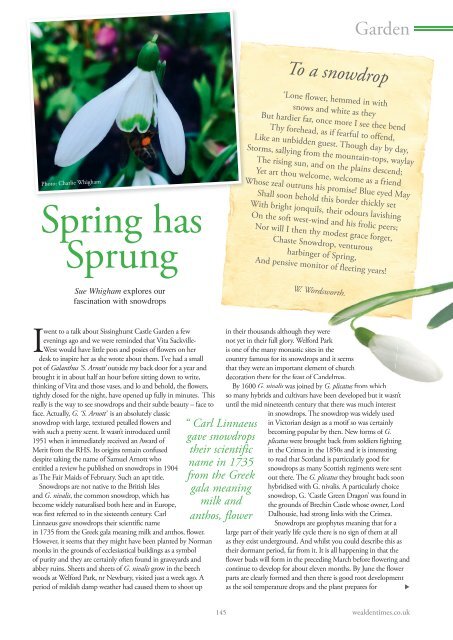Wealden Times | WT181 | March 2017 | Fashion supplement inside
Wealden Times - The lifestyle magazine for the Weald
Wealden Times - The lifestyle magazine for the Weald
You also want an ePaper? Increase the reach of your titles
YUMPU automatically turns print PDFs into web optimized ePapers that Google loves.
Garden<br />
To a snowdrop<br />
‘Lone flower, hemmed in with<br />
snows and white as they<br />
But hardier far, once more I see thee bend<br />
Thy forehead, as if fearful to offend,<br />
Like an unbidden guest. Though day by day,<br />
Storms, sallying from the mountain-tops, waylay<br />
Photo: Charlie Whigham<br />
The rising sun, and on the plains descend;<br />
Yet art thou welcome, welcome as a friend<br />
Whose zeal outruns his promise! Blue eyed May<br />
Spring has<br />
Sprung<br />
Shall soon behold this border thickly set<br />
With bright jonquils, their odours lavishing<br />
On the soft west-wind and his frolic peers;<br />
Nor will I then thy modest grace forget,<br />
Chaste Snowdrop, venturous<br />
harbinger of Spring,<br />
And pensive monitor of fleeting years!<br />
Sue Whigham explores our<br />
fascination with snowdrops<br />
W. Wordsworth.<br />
I<br />
went to a talk about Sissinghurst Castle Garden a few<br />
evenings ago and we were reminded that Vita Sackville-<br />
West would have little pots and posies of flowers on her<br />
desk to inspire her as she wrote about them. I’ve had a small<br />
pot of Galanthus ‘S. Arnott’ outside my back door for a year and<br />
brought it in about half an hour before sitting down to write,<br />
thinking of Vita and those vases, and lo and behold, the flowers,<br />
tightly closed for the night, have opened up fully in minutes. This<br />
really is the way to see snowdrops and their subtle beauty – face to<br />
face. Actually, G. ‘S. Arnott’ is an absolutely classic<br />
snowdrop with large, textured petalled flowers and<br />
with such a pretty scent. It wasn’t introduced until<br />
1951 when it immediately received an Award of<br />
Merit from the RHS. Its origins remain confused<br />
despite taking the name of Samuel Arnott who<br />
entitled a review he published on snowdrops in 1904<br />
as The Fair Maids of February. Such an apt title.<br />
Snowdrops are not native to the British Isles<br />
and G. nivalis, the common snowdrop, which has<br />
become widely naturalised both here and in Europe,<br />
was first referred to in the sixteenth century. Carl<br />
Linnaeus gave snowdrops their scientific name<br />
in 1735 from the Greek gala meaning milk and anthos, flower.<br />
However, it seems that they might have been planted by Norman<br />
monks in the grounds of ecclesiastical buildings as a symbol<br />
of purity and they are certainly often found in graveyards and<br />
abbey ruins. Sheets and sheets of G. nivalis grow in the beech<br />
woods at Welford Park, nr Newbury, visited just a week ago. A<br />
period of mildish damp weather had caused them to shoot up<br />
“ Carl Linnaeus<br />
gave snowdrops<br />
their scientific<br />
name in 1735<br />
from the Greek<br />
gala meaning<br />
milk and<br />
anthos, flower<br />
in their thousands although they were<br />
not yet in their full glory. Welford Park<br />
is one of the many monastic sites in the<br />
country famous for its snowdrops and it seems<br />
that they were an important element of church<br />
decoration there for the feast of Candelmas.<br />
By 1600 G. nivalis was joined by<br />
G. plicatus<br />
from which<br />
so many hybrids and cultivars have been developed but it wasn’t<br />
until the mid nineteenth century that there was much interest<br />
in snowdrops. The snowdrop was widely used<br />
in Victorian design as a motif so was certainly<br />
becoming popular by then. New forms of G.<br />
plicatus were brought back from soldiers fighting<br />
in the Crimea in the 1850s and it is interesting<br />
to read that Scotland is particularly good for<br />
snowdrops as many Scottish regiments were sent<br />
out there. The G. plicatus they brought back soon<br />
hybridised with G. nivalis. A particularly choice<br />
snowdrop, G. ‘Castle Green Dragon’ was found in<br />
the grounds of Brechin Castle whose owner, Lord<br />
Dalhousie, had strong links with the Crimea.<br />
Snowdrops are geophytes meaning that for a<br />
large part of their yearly life cycle there is no sign of them at all<br />
as they exist underground. And whilst you could describe this as<br />
their dormant period, far from it. It is all happening in that the<br />
flower buds will form in the preceding <strong>March</strong> before flowering and<br />
continue to develop for about eleven months. By June the flower<br />
parts are clearly formed and then there is good root development<br />
as the soil temperature drops and the plant prepares for<br />
<br />
145 wealdentimes.co.uk


















